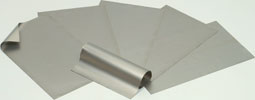Magnetic sheets use metallic glass powder to increase RFID antenna sensitivity
2 November 2005
Passive Components

Alps Electric has developed new magnetic sheets that utilise metallic glass powder to boost the sensitivity of RFID (radio frequency identification) antennas.
RFID has recently been gaining attention as a technology that stores data on a minute wireless tag to identify people or manage goods. In recent years, non-contact power transmission technology has led to the appearance of wireless tags, which can be used semi-permanently without a battery, and with a variety of applications including pre-paid cards.
Alps developed the HMLSR Series of Liqualloy magnetic sheets to enhance electromagnetic compatibility (EMC), eliminating the problem of interference with waves that should reach the wireless tag from radio or electromagnetic waves generated by nearby parts and devices.
The sheet uses Alps' proprietary Liqualloy, a metallic glass powder consisting primarily of iron. According to the company, its amorphous structure allows a high degree of freedom in the shaping process, and it displays soft magnetic properties that can be readily activated by exposure to magnetic fields. In addition, its high permeability is 1,3 times greater than that of Fe-Al-Si alloys, the leading magnetic material, giving it superior capacity to absorb radio and electromagnetic waves, it says.
In RFID technology, it is not unusual to install parts and devices on the back of the wireless tag antennas. Under some conditions, this causes interference with waves that should reach the antenna. Alps claims these new sheets effectively focus waves to the antenna, increasing RFID antenna sensitivity.
www.alps-europe.com
Further reading:
PCB connectors for power systems
Phoenix Contact
Passive Components
With the new PC 6 PCB connectors with screw connection, Phoenix Contact’s classic connection technology is available with enhanced touch protection for the new pin connector pattern.
Read more...
Polymer caps with very high ripple current capability
RS South Africa
Passive Components
TDK Corporation has released the B40910 series of hybrid polymer capacitors, which can handle up to 4,6 A at 100 kHz and 125°C.
Read more...
SPE connector range
Phoenix Contact
Passive Components
Single Pair Ethernet (SPE) is a communication technology that realises Industry 4.0 and IIoT applications, and Phoenix Contact’s Combicon range are ideal for SPE connections.
Read more...
TDK expands MLCC series
RS South Africa
Passive Components
TDK Corporation has expanded its CGA series of multilayer ceramic capacitors, currently being the highest capacitance in 100 V products for automotive applications.
Read more...
Inductor supports temperatures up to 150°C
RS South Africa
Passive Components
TDK has launched a highly durable inductor for automotive A2B applications that supports a wide temperature range of -55 up to 150°C.
Read more...
Long-range passive infrared motion sensor
Future Electronics
Passive Components
Panasonic Industry (PaPIRs) recently introduced he world’s most compact long-range passive infrared motion sensor, for installation heights of up to 15 metres.
Read more...
Isolated solid state relay
Altron Arrow
Passive Components
The ISO808, ISO808-1 (PowerSO-36) and ISO808Q, ISO808Q-1 (TFQFPN32) are galvanic isolated eight-channel drivers featuring a low supply current.
Read more...
Low-profile power inductors
RS South Africa
Passive Components
TDK Corporation has announced the introduction of its new PLEA85 series of high-efficiency power inductors developed for battery-powered wearables and other devices.
Read more...
Miniature capacitor for automotive applications
Avnet Abacus
Passive Components
Murata has released its LLC series of multi-layer ceramic capacitors for automotive applications, that feature a reversed termination for low ESL.
Read more...
Sealed tantalum capacitors
Electrocomp
Passive Components
With an operating temperature range of -55 to 125°C, with voltage derating, these capacitors have been designed especially for avionics and aerospace applications.
Read more...

